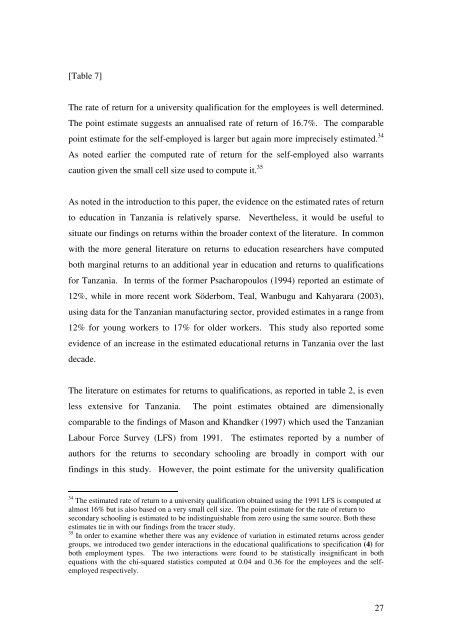Education, Employment and Earnings of Secondary School-Leavers ...
Education, Employment and Earnings of Secondary School-Leavers ...
Education, Employment and Earnings of Secondary School-Leavers ...
Create successful ePaper yourself
Turn your PDF publications into a flip-book with our unique Google optimized e-Paper software.
[Table 7]The rate <strong>of</strong> return for a university qualification for the employees is well determined.The point estimate suggests an annualised rate <strong>of</strong> return <strong>of</strong> 16.7%. The comparablepoint estimate for the self-employed is larger but again more imprecisely estimated. 34As noted earlier the computed rate <strong>of</strong> return for the self-employed also warrantscaution given the small cell size used to compute it. 35As noted in the introduction to this paper, the evidence on the estimated rates <strong>of</strong> returnto education in Tanzania is relatively sparse. Nevertheless, it would be useful tosituate our findings on returns within the broader context <strong>of</strong> the literature. In commonwith the more general literature on returns to education researchers have computedboth marginal returns to an additional year in education <strong>and</strong> returns to qualificationsfor Tanzania. In terms <strong>of</strong> the former Psacharopoulos (1994) reported an estimate <strong>of</strong>12%, while in more recent work Söderbom, Teal, Wanbugu <strong>and</strong> Kahyarara (2003),using data for the Tanzanian manufacturing sector, provided estimates in a range from12% for young workers to 17% for older workers. This study also reported someevidence <strong>of</strong> an increase in the estimated educational returns in Tanzania over the lastdecade.The literature on estimates for returns to qualifications, as reported in table 2, is evenless extensive for Tanzania. The point estimates obtained are dimensionallycomparable to the findings <strong>of</strong> Mason <strong>and</strong> Kh<strong>and</strong>ker (1997) which used the TanzanianLabour Force Survey (LFS) from 1991. The estimates reported by a number <strong>of</strong>authors for the returns to secondary schooling are broadly in comport with ourfindings in this study. However, the point estimate for the university qualification34 The estimated rate <strong>of</strong> return to a university qualification obtained using the 1991 LFS is computed atalmost 16% but is also based on a very small cell size. The point estimate for the rate <strong>of</strong> return tosecondary schooling is estimated to be indistinguishable from zero using the same source. Both theseestimates tie in with our findings from the tracer study.35 In order to examine whether there was any evidence <strong>of</strong> variation in estimated returns across gendergroups, we introduced two gender interactions in the educational qualifications to specification (4) forboth employment types. The two interactions were found to be statistically insignificant in bothequations with the chi-squared statistics computed at 0.04 <strong>and</strong> 0.36 for the employees <strong>and</strong> the selfemployedrespectively.27
















